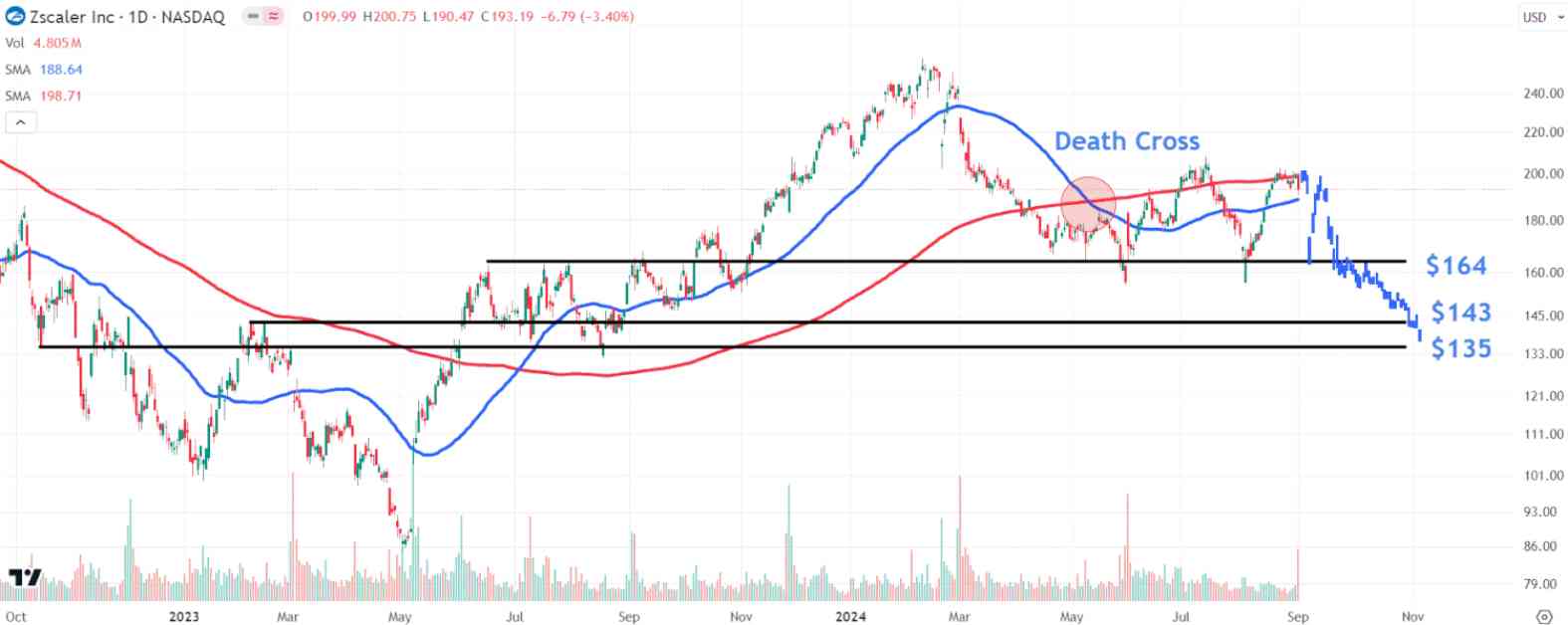Zscaler, a provider of cloud-based cybersecurity services, experienced a significant drop in its stock price after issuing earnings guidance that fell short of analysts’ expectations. This disappointment came as enterprise customers are becoming more cautious with their technology budgets and spending in the face of economic uncertainty.
Analyzing the technical aspects of Zscaler’s stock chart can provide valuable insights for investors navigating the projected earnings-driven decline. Since the 50-day moving average (MA) crossed below the 200-day MA in May, Zscaler shares have been trading mostly sideways. Recent rallies up to the 200-day MA in July and August faced resistance, indicating a strong selling pressure in the stock.
In after-hours trading on Tuesday, Zscaler’s stock fell by 15.1% to $164.10, following a 3.4% decline during regular trading amid a broader market selloff. As investors brace for further price weakness, it’s crucial to monitor key chart levels that may attract buying interest amidst the post-earnings selling pressure.
Key Levels to Watch
Investors should pay attention to three significant chart levels as potential support zones for Zscaler shares. The first level to watch is at $164, where the stock is likely to find support near a trendline connecting three prominent swing highs from June to September last year, along with trading activity around this year’s May and August lows.
If selling pressure persists, Zscaler shares could potentially drop to the $143 level, where investors may find entry points near the peak in February 2023 and a range of comparable price action from June to August last year. A further downturn might lead to the stock revisiting lower support around $135, an area on the chart that could attract buying interest near a horizontal line connecting trading levels between October 2022 and August last year.
Interestingly, this $135 support level coincides with a bars pattern price target derived from the stock’s sharp downward move from February to April, positioned from last month’s high. Notably, a 14% drop occurred near the beginning of the prior decline, similar in magnitude to the expected earnings-induced drop on Wednesday.
It’s essential to note that the information, opinions, and analyses expressed are for informational purposes only. Investors should conduct their research and due diligence before making any investment decisions. As of the date of writing this article, the author does not hold any securities mentioned.
Investor Sentiment and Market Outlook
The disappointing earnings guidance from Zscaler reflects broader concerns about the economic environment and technology spending among enterprise customers. As businesses navigate uncertainties, they are likely to be more cautious with their budgets, impacting companies like Zscaler that provide cybersecurity services.
The market selloff and subsequent drop in Zscaler’s stock price highlight the volatility and sensitivity of the current market environment. Investors are closely monitoring earnings reports and guidance from companies to assess the impact of economic conditions on various sectors.
While the near-term outlook for Zscaler may face challenges, the long-term prospects for the company remain robust. As cybersecurity threats continue to evolve and businesses prioritize digital security, companies like Zscaler are positioned to benefit from the growing demand for cloud-based cybersecurity solutions.
Opportunities for Growth and Innovation
Despite the short-term challenges facing Zscaler, there are opportunities for growth and innovation in the cybersecurity space. As businesses increasingly rely on cloud-based services and digital technologies, the need for robust cybersecurity measures has never been more critical.
Zscaler’s expertise in cloud-based cybersecurity solutions positions the company as a leader in the industry. By leveraging cutting-edge technology and staying ahead of emerging threats, Zscaler can continue to provide valuable services to its customers and drive growth in the long term.
Investors should consider the broader trends shaping the cybersecurity landscape and the potential for Zscaler to capitalize on the growing demand for advanced security solutions. As businesses prioritize data protection and cybersecurity, companies like Zscaler are well-positioned to benefit from this trend.
Conclusion
Despite the recent price drop following disappointing earnings guidance, Zscaler remains a key player in the cloud-based cybersecurity space with strong growth potential. Investors should closely monitor key chart levels and market developments to navigate the current volatility and position themselves for long-term success in the cybersecurity sector. By staying informed and conducting thorough research, investors can make informed decisions and capitalize on opportunities for growth and innovation in the cybersecurity industry.

















